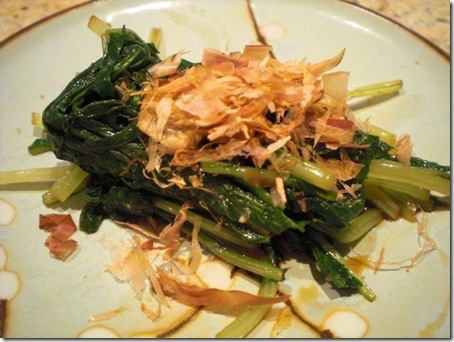
“Ohitashi” means “soaked”. Originally, vegetables (mostly leafy greens) were boiled and then “soaked” in a broth or dashi 出汁. The excess liquid was then squeezed out and it was seasoned with soy sauce. More commonly, however, the soaking step was omitted and the boiled leafy vegetable with soy sauce on top is called “Ohitashi”.
Mizuna: One package of mizuna was composed of about 6 individual plants measuring about 12 inches long. As with any leafy vegetable, it looked like a lot but after cooking the volume decreased quite a bit. I washed the stalks and lined them up so that all the leafy parts were on one side and the root ends on the other. I cut off the root end and cut the remainins stalks in half so that one bunch was mostly leafy and the other was mostly stalks.
I first cooked the stalks in salted boiling watr for 30-40 seconds and then added and cooked the leafy part for another 30 seconds. I drained the cooked greens in the colander. Spread the cooked mizuna flat and cooled it down by fanning. You could shock it in ice cold water but this is easier and the mizuna will not get too watery.
Dressing: Instead of “broth” which may have been used in the original form of “ohitashi”, I made mustard/soy sauce mixture or “karashi shouuyu” 芥子醤油. I put about 1/2 tsp of Japanese hot mustard (from a tube), sugar (1/4 tsp) and soy sauce (2 tsp) in a Japanese mortar or “suribachi” すり鉢 and mixed all together using a pestle or “surikogi” すりこ木.
I squeezed out any excess moisture from the cooked mizuna and then cut into pieces about 2 inch long. I dressed with the above karashi shouuyu. I placed it in a small dish as seen above. I garnished with dried bonito flakes “Katsuobushi” 鰹節 (pre-shaven and came in a small plastic pouch). Just before eating, you may want to moisten the bonito flakes with a bit of additional soy sauce (which we did).
This is more for the texture than the taste of the green itself but, nevertheless, very refreshing small dish which can go well with your Japanese style dinner/breakfast or drinking snack. “Ohitashi” can be made any vegetables but the most common is using spinach. When using spinach, especially the Japanese variety, you should soak the spinach in cold water after boiling to remove oxalic acid.

No comments:
Post a Comment